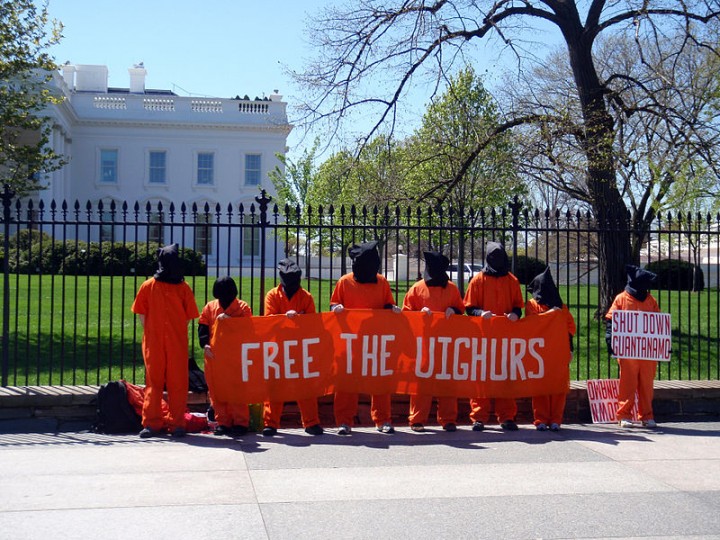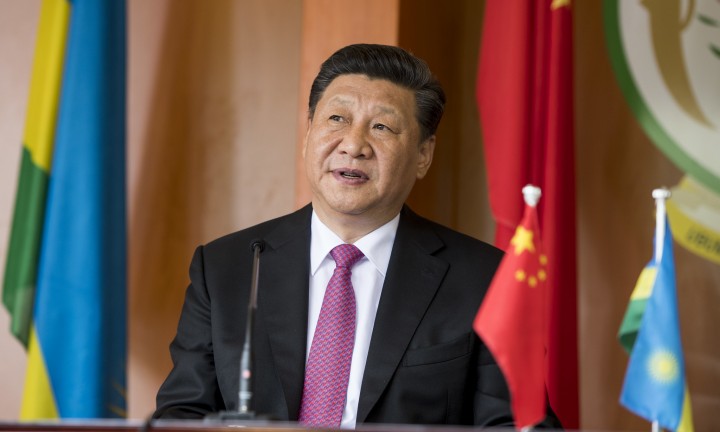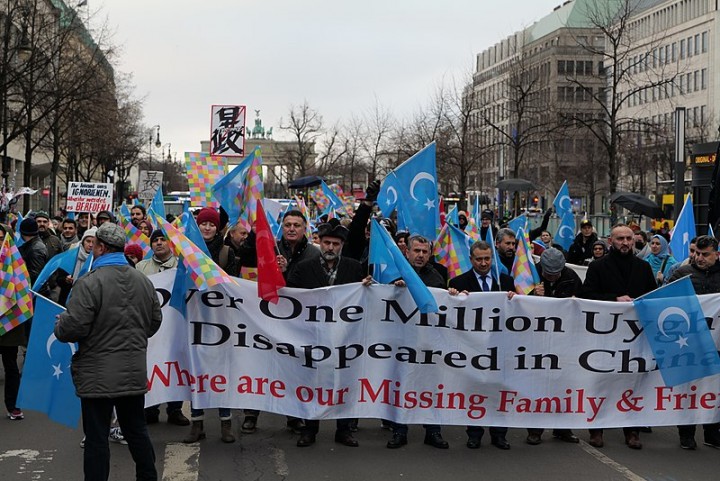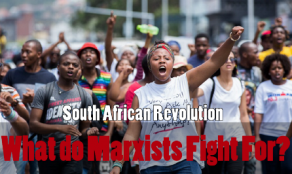Both the US and British governments have recently launched a barrage of criticism against China’s treatment of the Uyghurs. The US has gone as far as imposing sanctions on top Chinese state officials responsible for Xinjiang, and the oppression of the Uyghurs by the Chinese state is now regularly featured in the news in the West. According to reports by the capitalist press, hundreds of thousands of Uyghurs are being detained in prison camps, whilst others face extremely repressive conditions. But why only now have western imperialists hypocritically taken up the plight of the Uyghurs?
While there is no doubt that the Chinese state is carrying out national oppression against the Uyghurs, with these criticisms the British and US states are like pots calling the kettle black.
The western imperialists have perfected the art of racist oppression over centuries, both at home and worldwide. Behind their alleged concern for the Uyghurs lies a concern for maximising their profits – at the expense of China, of course. They are simply using the Uyghurs as a convenient lever with which to apply pressure on China in their ongoing trade war.
Open air prison
The Uyghurs are indeed an oppressed national minority, inhabiting the far-western Xinjiang region of China. Ethnically, the Uyghur people are Turkic, have a distinct culture, and speak their own language.
Despite living in the so-called “Xinjiang Uyghur Autonomous Region”, the Uyghurs are subject to a totalitarian regime imposed by the so-called Chinese ‘Communist’ Party (CCP).Their right to practice their culture is heavily suppressed.
Uyghurs have been oppressed for centuries. However, since the mid 2010s, the policy of the Chinese state has been to essentially crush any independent national identity of the Uyghurs. This has been carried out through their forced assimilation into the dominant Han culture, combined with brutal state repression.
Over the recent years, the Chinese state has clamped down hard on the Uyghur’s culture. This has included severely limiting the teaching of the Uyghur language in schools, and effectively banning the sale of most Uyghur-language books. Certain displays of ‘religious behaviour’ are enough to get you into trouble, including the ‘abnormal growing of beards’, and wearing veils in public.
Even more so than the rest of China, the Uyghurs in Xinjiang are subject to intense state surveillance. This is carried out through a tight network of police checkpoints, facial recognition CCTV, and even tracking devices on cars and phones. And under the ‘Han-Uyghur One Family’ programme, 112,000 Han CCP members were assigned to visit Uyghur families for regular checks and monitoring.
Those that fall afoul of the authorities are often sent to ‘re-education camps’, or given severe prison sentences. The western media often repeats the claim that between 1 to 1.5 million Uyghurs and other minority groups have been sent to such camps over the past few years.
However, as detailed here, such claims originate from just two very right-wing sources, and appear to be based on extrapolations from verbal accounts of just eight Uyghurs. In reality, the numbers detained are likely to be far fewer. Nevertheless, the existence of such camps is not disputed by the Chinese state, which refers to them as “vocational educational and training centres”.
The Uyghur national question
 China's increased oppression of the Uyghurs cannot be understood without understanding the national question in Xinjiang / Image: EnricX, Flickr
China's increased oppression of the Uyghurs cannot be understood without understanding the national question in Xinjiang / Image: EnricX, Flickr
Why has China ramped up this oppression in the recent period? This cannot be understood without first understanding the history of the national question in Xinjiang.
Xinjiang is a key region for the Chinese ruling class, both for its natural resources, and its strategic location as a gateway to Central Asia. Although the region is mostly desert and mountains, it holds China’s largest natural gas reserves, 40 percent of its coal, and 22 percent of its oil.
The region has long been a flashpoint for national conflict. As is typical with smaller nations, the interests and rights of the Uyghurs have been trampled underfoot by the larger powers for centuries.
The region came under the indirect rule of China in the 1750s, until it was incorporated officially into the Chinese empire in the 1880s.
Legacy of Stalinism
Later, in the 1920s and 30s, the area was swept up in the revolutionary ferment that gripped Central Asia in the wake of the Russian Revolution. One by one, the many peoples of the region rose against despotism, national and religious oppression, and Han Chinese chauvinism.
However, instead of supporting these movements, helping them come to power and incorporating them into the Soviet Union, the Stalinist bureaucracy of the USSR manoeuvred, often against the national liberation movements. The Stalinists collaborated with the most reactionary forces, and at all times kept Xinjiang and its revolutionary forces at arm’s length. Finally, in 1934 the Stalinists backed a Chinese warlord, Sheng Shicai, to take power in the region, but refused to incorporate his regime into the USSR.
Socialism is international or it is nothing. The Russian Revolution was a great example of this. Here, the oppressed nations of the Russian empire united with the Russian working class in a common struggle against the great Russian imperialist reaction.
Following the Russian Revolution there was a flowering of class unity across national borders. The national question receded and a mood of solidarity and collaboration towards a common future pervaded the Soviet Union. Throughout the writings of Lenin and Trotsky, it is abundantly clear that the only way forward for the masses of Russia was a struggle against capitalism internationally. This was reflected in all the policies of the Soviet Union and the Comintern in its early years.
But with the degeneration of the Soviet Union and the rise of Stalinism, all of this went into reverse. By its very nature, Stalinism was thoroughly chauvinist in its outlook. The aim of the Soviet bureaucracy was not world revolution, but self-preservation. On this basis all the old crap, of oppression, discrimination and reactionary great Russian chauvinism slowly crept back.
It was on this basis, reflecting the narrow nationalist interests of Stalinism that Stalin developed the theory of ‘socialism in one country’. On the basis of this theory, countless revolutionary movements were derailed and led to a bloody end.
For Stalin, the fate of Xinjiang and its people had nothing to do with class struggle. In fact, one of the main reasons for the Soviet army’s intervention – alongside reactionary white Russian forces! – in the region in the 30s was to stop the rebellions from spreading into the Soviet Union. This reflected, not only the reactionary nature of Stalinism internationally, but also the conditions of the oppressed nations inside the Soviet Union.
Furthermore, Stalin was holding Xinjiang at bay as a concession to the bourgeois nationalist and counter-revolutionary Kuomintang (KMT). It was only in 1949, seeing the unstoppable advance of the Chinese Revolution, that Stalin did a deal with Mao to transfer control of the area to the newly formed People’s Republic of China (PRC).
Undoubtedly, this was partially to avoid the revolution spilling over into the USSR itself.
A genuine working-class internationalist policy would have seen the PRC join the USSR on an equal footing with all the Soviet republics. Instead, both bureaucracies pursued their own nationalist policies, alongside cultivating their own spheres of influence. The logic of this was revealed with the Sino-Soviet split in the mid 1950s and 60s.
Under Mao, Xinjiang was not ruled on the basis of proletarian internationalism. Fundamentally, Maoism and Stalinism were the same phenomena. The Chinese workers and peasants swept away capitalism and installed a workers’ state, but the so-called “Communist” bureaucracy held power instead of the working masses. On this basis, while China took huge steps forward on the basis of the planned economy, all the reactionary traits of Stalinist Russia were replicated there.
For the Uyghurs, this meant the continuation of a cynical nationalist approach where the bureaucracies of the USSR and of the PRC used the Uyghur national question to further their own immediate narrow national interests.
At the same time, the Chinese state denied the right of national self-determination to the Uyghurs, when Xinjiang was incorporated into the PRC. The new Chinese state after the revolution was modelled on the Russian Stalinist state of the late 1940s, rather the Bolshevik policies of Lenin and Trotsky. A limited form of regional self-government was granted to the region. However this did not extend to granting the right for the region to secede from the PRC, should its people so choose.
Although Xinjiang was established as a “Uyghur Autonomous Region” in 1955, in reality it has been controlled through a semi-military organisation called the Xinjiang Production and Construction Corps (XPCC), also known as Bingtuan.
The XPCC was established in 1954 to populate the border areas of the new Chinese republic with Han Chinese people, using demobilised soldiers from the civil war. It has always fallen under the direct authority of the CCP in Beijing, rather than the administrative government of Xinjiang. Given the nationalist nature of the CCP bureaucracy, the national question in Xinjiang was never resolved.
Cynicism
 Why have the imperialists only now started paying attention to the plight of the Uyghurs? This is rank hypocrisy and opportunism / Image: Daniel Lobo
Why have the imperialists only now started paying attention to the plight of the Uyghurs? This is rank hypocrisy and opportunism / Image: Daniel Lobo
As part of the Sino-Soviet conflict of the 1960s, the USSR actively fostered separatist tendencies in Xinjiang, chiefly by promoting Uyghur nationalism. This had nothing to do with supporting the national aspirations of the Uyghurs. Instead it was a cynical ploy to further the interests of the Soviet bureaucracy by weakening the Chinese state – one of the many crimes of Stalinism.
As part of this policy, the USSR funded the East Turkestan Peoples’ Revolutionary Party, in order to start a violent uprising in Xinjiang in 1968. The policy contributed to an actual military conflict along the Soviet-Chinese border in 1969.
Later, China – in league with the USA – played a role in supporting the counterrevolutionary Afghan Mujahideen, following the Soviet intervention in Afghanistan in 1979. They set up training camps for Islamic fundamentalists in Xinjiang, and provided them with weapons and funds. The policy of the Chinese bureaucracy was based on the premise of ‘the enemy of my enemy is my friend’, thus supporting all sorts of reactionary forces across the world, from Afghanistan to Chile and Angola, in its conflict with the Stalinist bureaucracy in the USSR.
At the same time, the Chinese bureaucracy ramped up the migration of Han Chinese into Xinjiang, to counter the Soviet influence amongst the Uyghurs. In 1949, the Han Chinese comprised only 6 percent of the population of Xinjiang, which was 75 percent Uyghur. Now the ratio is 40 percent Han, and 45 percent Uyghur, although this is geographically uneven. Han are a majority in the eastern and northern parts, and Uyghurs a majority (70 to more than 95 percent) in the south and west. The Han are also overwhelmingly urban.
The XPCC was used for this purpose. As a result, the bulk of economic development in the region benefited mostly Han Chinese migrant workers and the bureaucracy. The bulk of the wealth of the region was extracted out of Xinjiang to the east, with little benefit to the local Uyghurs.
This led to increasing resentment of the Uyghurs towards the Han Chinese, and a growing feeling of national oppression. As Lenin explained, at the root of the national question is the issue of bread – i.e. living standards.
Boiling point
With the gradual restoration of capitalism, the national oppression of the minorities also increased. Tensions increased in the 1990s, following a number of small terrorist attacks and uprisings against the Han Chinese. In response, the Chinese state stepped up its repression against the Uyghurs.
Things reached a boiling point in 2009, when a fight broke out in a factory in southern China, in which two Uyghurs were killed by Han Chinese workers. A protest was organised in Urumqi – the regional capital of Xinjiang – demanding a government investigation into the killings.
The terrorist threat from Islamic fundamentalists in Xinjiang is indeed real. It is estimated that about 1,500 Uyghurs went to fight in Iraq and Syria for the Islamic State, or other reactionary jihadist groups. And within Xinjiang are remnants of the old Afghan Mujahideen, as well as Turkic and other central Asian reactionary forces.
However, the Chinese state has used the issue of Islamic fundamentalism and terrorism as an excuse to ramp up its oppressive measures against all Uyghurs, as well as the Chinese working class in general. But by crushing the Uyghur’s culture, and making the whole nation responsible for the acts of a small number of extremists, the Chinese state is in fact pushing more and more Uyghurs towards fundamentalism.
Social explosion
 The Islamic terrorist threat in Xianjiang is real, but the repressive measures of the Chinese state will make this situation worse / Image: Paul Kagame, Flickr
The Islamic terrorist threat in Xianjiang is real, but the repressive measures of the Chinese state will make this situation worse / Image: Paul Kagame, Flickr
In reality, the state is more concerned about a mass social explosion in Xinjiang than small groups of fundamentalists. Given the increasing ferment of the working class throughout China, a mass movement in Xinjiang could rapidly spread throughout the country.
China has been spending more on ‘internal security’ than ‘external defence’ since 2010, due to increasing class struggle and unrest. The bureaucracy is clearly fearful of social explosions. With the growth of the economy slowing down, the bureaucracy is looking towards Han Chinese nationalism and increasing repression in order to preserve its rule.
The bureaucracy is using the issue of Uyghur unrest and terrorism as a means to distract from the growing problems faced by the working class all over China. It is a classic policy of divide and rule. At the same time, the totalitarian security regime imposed on Xinjiang is seen as a testing ground for methods that will likely be deployed throughout China, when the class struggle heats up.
The Chinese ruling class cannot afford to lose control of Xinjiang. As well as possessing enormous energy reserves, the key oil and gas pipelines supplying China from Central Asia pass through it. It shares a border with seven other countries, and is therefore vital for developing China’s Belt and Road Initiative (BRI) – a key pillar of China’s imperialist aspirations.
According to Xinhua, Xinjiang is designed to be a key logistical hub within the BRI. A freight centre in the regional capital Urumqi is already handling 3,600 tonnes of cargo per day. This centre traffics not only natural resources, but also commodities such as garments and electronic components, with the involvement of more than 200 companies. Any level of instability would make maintaining and expanding these initiatives impossible, hence the CCP opted for swift and widespread repression.
The development of Xinjiang through the XPCC is also used by the Chinese state to help mop up unemployment in the east of China. The XPCC employs over 3 million workers, 86 percent of which are Han. With the Chinese economy slowing down, and rising unemployment, this is seen as increasingly important to the stability of the Chinese regime. The idea is to develop other areas of the country, now that rising wages in the coastal regions in the South and the East have eroded the advantage they had in manufacturing cheap labour export products. Huge investments have gone into developing new cities in Xinjiang, along the land route to Central Asia and Europe.
As well as a paramilitary apparatus, the XPCC also has a significant agribusiness division, producing cotton and tomatoes.
Recently, the XPCC has embarked on a massive programme of land reclamation, employing thousands of Han Chinese to ‘reclaim’ and farm desert areas. The output of the XPCC has therefore doubled between 2013 and 2017 to $36.7 billion – which if it were a country, would rank it 99th in the world in terms of GDP.
However, in ‘reclaiming the desert’, the Uyghurs are often forced off their land, so that water resources can be diverted to the XPCC farms. This, along with the continued migration of Han Chinese into traditionally Uyghur areas of the south and west of Xinjiang, is contributing to the rising tensions in the area.
Crocodile tears
The brutal oppression of the Uyghurs has been well documented for years. So why only recently have the American and British governments taken an interest in the area?
On 17 July, the US government passed the ‘Uyghur Human Rights Policy Act of 2020’. The bill requires US state institutions to identify Chinese officials involved in the “arbitrary detention, torture, and harassment” of Uyghurs, in order that sanctions may be imposed upon them.
The hypocrisy of the US state is breathtaking. Presumably those American officials involved in the “arbitrary detention, torture, and harassment” of countless thousands in the so-called ‘war on terror’, will be exempt from this, or any other bill.
Indeed the US state knows a thing or two about detaining and harassing Uyghurs, having sent 22 of them to its own torture camp in Guantanamo bay! And according to John Bolton – the former US national security advisor – Donald Trump is alleged to have told the Chinese president Xi Jinping in 2019 that building concentration camps to ‘re-educate’ Uyghurs was “the right thing to do”.
The US is certainly no friend of the Muslim peoples, having brutally invaded and occupied Iraq and Afghanistan for nearly two decades.
When it comes to imprisoning its population, the USA is by far the world leader, both absolutely, and per capita. The USA imprisons almost 2.3 million people, which is 698 per 100,000 of its population. By contrast, China imprisons 118 per 100,000. Whilst the USA has only 4.4 percent of the world’s population, it is home to 22 percent of the world’s prisoners.
Where are the calls for sanctions against the US state for its own racist imprisonment of minorities? Despite making up only 13 percent of the population, black Americans make up nearly 40 percent of the US prison population, with the incarceration rate for black men 5.8-times higher than that of white men.
And where are the human rights enquiries into the treatment of refugees at the Mexican border, where families have been separated, and hundreds squeezed into standing room cells for a week on end, with no sanitation? Or the brutal treatment of protestors, as seen recently with the Black Lives Matter movement?
When it comes to the crimes of US imperialism abroad, the list is too long to recall. And as for the crimes of the British state, they are guilty of all of the above, only on a reduced scale.
Trade war
In reality, the proposed sanctions against Chinese officials have nothing to do with concern for Uyghur human rights, but everything to do with the developing conflict between the American and Chinese ruling classes and their ongoing trade war. The threat of sanctions is just one of many levers being used to put pressure on the Chinese government to submit to America’s terms.
The bill itself contains a provision whereby the US president can hold off enforcing sanctions, if it is in “the national interest” (i.e. big-business interests) of the USA to do so. In other words, if the Chinese state submits to favourable trade terms with the USA, it can continue to treat the Uyghurs as it pleases.
As is typical with the fate of oppressed nations, the rights of the Uyghurs are being used simply as bargaining chips in the struggles of the large imperialist powers.
For years, the British government has turned a blind eye to the Chinese state’s actions in Xinjiang. This was while Downing Street was desperately courting Chinese investment to prop up the lacklustre British economy.
With the growing conflict between China and Britain over Hong Kong, the Tories, whose foreign policy is dictated by subservience to Washington, have suddenly discovered the oppression of Uyghurs in Xinjiang. Dominic Raab, the UK foreign secretary, went so far as to describe China’s actions in Xinjiang as “deeply troubling”.
However Raab poured cold water on the idea of sanctions, since in his words he wants a “positive relationship” with China. In other words, the interests of British trade and investment take priority. Unlike the USA, the British imperialists are in no position to embark on a trade war against China.
Class struggle
 A truly independent Uyghur state on a capitalist basis is a utopia. Only a voluntary socialist federation of Asia could guarantee genuine liberation for all oppressed nations / Image: Leonhard Lenz
A truly independent Uyghur state on a capitalist basis is a utopia. Only a voluntary socialist federation of Asia could guarantee genuine liberation for all oppressed nations / Image: Leonhard Lenz
We must oppose sanctions (threatened or otherwise) by the UK and US. These will not relieve the oppression faced by the Uyghurs. For this, it is necessary to remove the Chinese regime, which is at the root of this oppression. This is the task of the working class in China (including Uyghur workers) alone. The American imperialists are no friends of the working class anywhere in the world, nor of any oppressed groups.
The CCP regime must be removed throughout all the regions of China, and replaced with genuine workers’ power. This can only be achieved through the united class struggle of the working class and poor – of all ethnic groups in China.
Han Chinese workers must therefore vigorously take up the struggle against the oppression of the Uyghurs, as a divided movement is a weakened movement. Genuine communists in China must inscribe on their banner the right of all nations to self-determination, in order to strengthen the voluntary unity of the working class.
We must be clear, however, that a truly independent Uyghur state on a capitalist basis is a utopia. An economically and militarily weak state, landlocked between China and Russia, would be defenceless in the face of intervention by larger imperialist powers. Or a flurry of regional powers could seek to intervene, leading to the balkanisation of Xinjiang as a region. Only a voluntary socialist federation of Asia could guarantee genuine liberation for all oppressed nations.
With the deepening world crisis of capitalism plunging China’s economy into reverse, it may not be long until the working class moves to put revolution on the order of the day.



